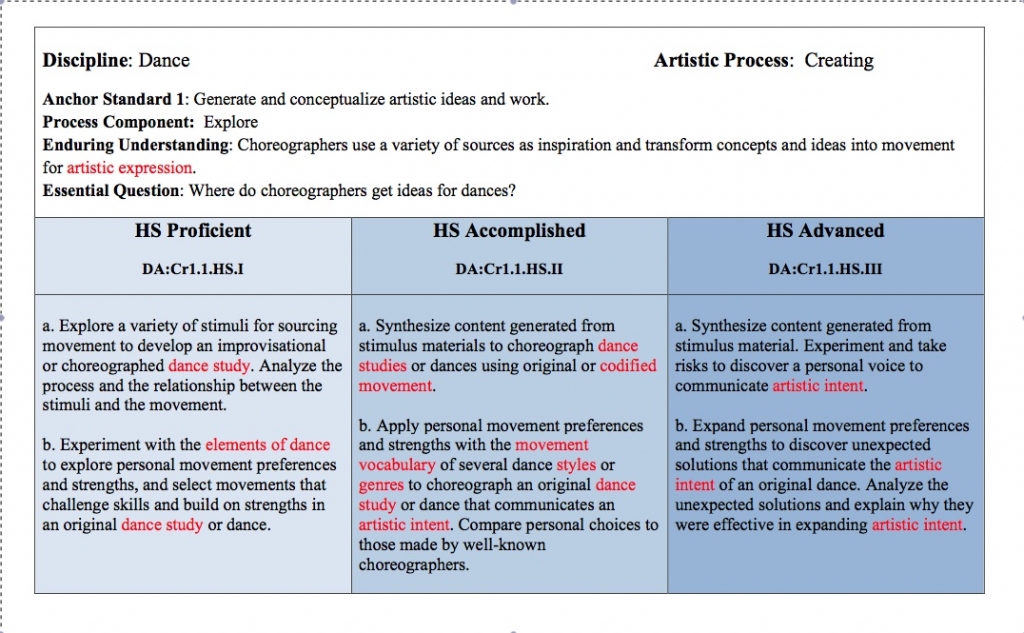Unpacking: Literally & Figuratively
5 Min Read • National Core Arts Standards
On Tuesday, my best friends came over to help me pack for my cross-country adventure. We began filling boxes with books, pictures, and memories. For about the first hour it was exciting and we were moving at a good pace; removing items from the walls, the shelves, the cupboards. And then I looked up.
All of a sudden I realized that all the things that made my house a home, were now gone, and all that was left were empty walls…and I sat down and cried. Everything that I have ever known was about to change; everyone that I ever knew was going to be left behind, and every part of my life was about to be different. This was a very overwhelming feeling; so exciting, yet so very scary, and I realized that this was very similar to the adventure we are about to embark upon with our new standards, maybe not as emotional or filled with boxes and bubble wrap, but the fact that everything we’ve taught, every way we’ve taught, everything we’ve known for the past few decades, is about to change…forever.
Over the next few months I will be unpacking, both literally and figuratively. Not only will I be unpacking a lifetime of boxes, but also a brand new set of core dance standards. So, I will be devoting the third week of each month (my strategy article) to unpacking these new standards and providing lesson seeds, plans, and assessments.
To preface the next 11 months of unpacking standards, we need to know how to actually unpack a standard. Fortunately, the State Agency Directors of Arts Education (SEADAE) and the National Coalition of Core Arts Standards (NCCAS) have already given us a jump-start on unpacking our Dance standards, which is so helpful, but now we need to really give thought to what our students need to know and be able to do in order for them to demonstrate the standards.
Let’s take a look at how SEADAE and NCCAS has laid out the standards for our comprehension:
Discipline
The National Core Arts Standards cover five disciplines, Dance, Media Arts, Music, Theatre, and Visual Arts. Each discipline carries the same artistic processes and anchor standards, but varies in enduring understanding, essential questions, and discipline-specific expectations.
Artistic Process
Each standard is linked to a specific process inspired by the 1997 National Assessment of Education Progress (NAEP). The processes are: creating, performing/presenting/producing, responding, and connecting. Again, these processes are the same across all five disciplines.
Process Component
The process components are the actual actions that the students are expected to complete which help to build towards the artistic processes. The process components for dance are explore, plan, revise, express, embody, present, analyze, interpret, critique, synthesize, and relate.
Enduring Understanding & Essential Questions
The enduring understanding and essential questions are adapted from the philosophies of Wiggins and McTighe. The enduring understanding is the big idea and the essential questions is meant to “stimulate thought, provoke inquiry, and spark more questions” (National Core Arts Standards: A conceptual Framework for Arts Learning, 2014). Mastery of the standard should be demonstrated by a students ability to grasp the enduring understanding and answer the essential question.
Performance Standards
The performance standards for secondary are separated by three categories: proficient, accomplished, and advanced. Each maintains discipline-specific vernacular but advances in cognitive abilities and demonstration.
So now, how do we unpack these standards and create thought provoking, inquiry seeking, exploratory practices in dance literacy?
Yesterday, Susan Riley sent out the Education Closet newsletter: Breaking Down the New Arts Standards, which offered some great tips at looking at our new standards.
She suggested to:
- Look at the cognitive demand. If the description of the standards requires analysis, evaluation, synthesis, or creating, students will be working at the highest levels of cognitive demand. This indicates a level of vigor in both processing and production.
- Pay attention to intent, not word choice. Don’t judge a standard by how it’s written; look at the content, Many of the new national standards are written in clear and succinct language, but this doesn’t mean they are “low level”.
- Collaborate and Break it Down. Work with other arts educators to determine the progression of the standards, how they are anchored, and the practices/processes needed to teach them. It’s important to spend the time unpacking the standards before implementation! (Riley, 2014)
We are going to take a look at the third tip: collaborate and break it down.
Unpacking the standards, much like unpacking moving boxes, should be done with friends! Additional hands and minds provide a support system for bouncing ideas and collectively analyzing the process. Luckily, the performance standards are already set up for unpacking.
Step 1: Take a look at the performance standard and pull out the nouns, or what students need to know.
Step 2: Now take a look at the performance standard and pull out what students need to be able to do (the verbs).
Step 3: prepare an idea or product revolving around the question “what does this look like in student work?”
Step 4: Work backwards. Step 3 will tell you your assessment of the standard. Now work backwards to create the actual lesson plan.
Over the next 11 months I will be working through this process, providing lesson seeds, plans, and assessments for each of the standards. Although they will overlap, as many standards can be utilized within each lesson, I will focus on a specific anchor standard each month. Be sure to take a look at the new arts framework: http://www.nationalartsstandards.org/content/conceptual-framework
Next Week: Teacher Talk
Susan Riley’s new book No Permission Required is an amazing testament to the power of STEAM. Utilizing the ARTISTIC critique, we will take a look at this influential resource.



